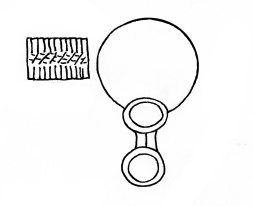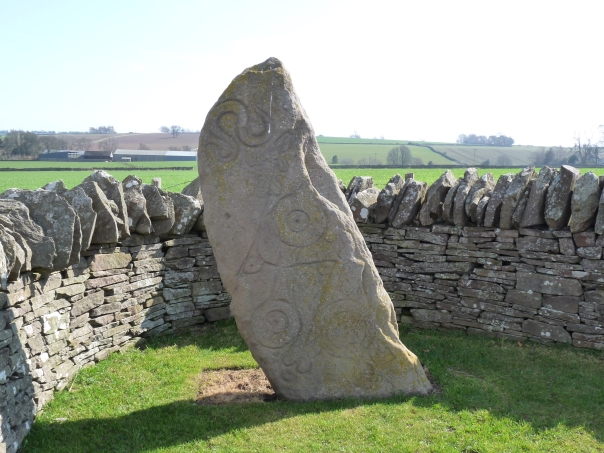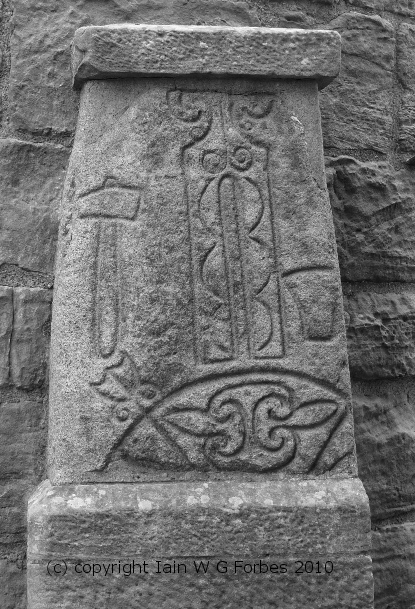The Pictish Mirror and the Comb symbols in Sky Divination
The ‘mirror’ and ‘comb’ symbols do not seem to be mainstream symbols but appear to be supplementary to the other symbols. They are usually smaller than the principal symbols, and appear typically below the main pairing. The mirror can appear on its own or with the comb, but there is no clear example of the comb appearing by itself, suggesting some form of logical coding or stratification. It may be that these two symbols were intended to convey additional information to the viewer about the combination of the mainstream symbol pairs; they therefore may act as ‘qualifiers’, providing further clarity to the message. An example of a stone bearing a mirror and comb alongside a symbol pair can be found in the picture of the Aberlemno 1 stone (bottom right of stone).
The most obvious place to start is the widely held notion that the mirror and comb somehow convey a feminine aspect to the interpretation of the symbols. According to previous theories on their function, if the two symbols represented someone’s name, then the mirror could indicate that the name was that of a female. Such an interpretation does not however explain the extra potential coding suggested by the addition of the comb symbol in a large number of cases. The ‘female hypothesis’ would of course be dependent on the Picts associating both these objects with femininity; an association for which we have no clear evidence. Why wouldn’t these objects also be an important item in male grooming? Mirrors would also have been relatively rare and therefore an item of status and it is just as likely that a mirror symbol conveys the notion of this status. The comb, however would seem to be a much more common item, and it is telling that it occurs only in the presence of the mirror.
The mirrors depicted appear to be typical of early medieval mirrors, and similar examples of these can be seen in various museums in Scotland and further afield, although some of the specific mirror designs carved on Pictish stones have not been found by archaeologists. The mirrors found are clearly opulent objects, often richly decorated and would have been considered a very desirable accessory. The combs, which can consist of a single or double row of teeth, are much more common, and can be made out of materials such as wood, bone, or rare and more valuable materials such as ivory.
Could these two symbols possibly fit with a calendrical, astronomical, or astrological interpretation of the Pictish stones? We could start with a relatively simple hypothesis; if the mirror is a symbol of value then its presence may tell the person viewing a particular stone that the astrological significance of the symbol pair it accompanies is higher than usual. Likewise, the addition of a comb could mean that the combination of symbols is of particular significance. This possibility might explain why mirrors are often associated with a rodded double disc, but there is no clear example of a mirror accompanying the simpler double disc without a rod. If we assume for the moment that a rodded version of a symbol had a higher status than its non-rodded counterpart, and if the mirror’s function was to convey the importance of the two symbols it accompanied, then a mirror and simple double disc occurring together would indeed be less likely.
There is however a significant feature of mirrors that provides evidence that the Pictish symbols may be astrological in nature; the fact that mirrors have attached to them a considerable folklore connecting them to future events. This folklore is still very much extant and it is still a commonly held belief that breaking a mirror will bring seven years bad luck. If we ask ourselves why the breakage of a mirror would have such dire consequences for the future, the mundane answer would be that, going back in time, the mirror, at least one made of glass, was originally a very valuable and fragile object and of course in this sense it would be ‘unlucky’ to smash one. This doesn’t explain why you would then experience further bad luck for many years to come. If breaking a mirror is unlucky, is there an implication that the intact mirror is somehow lucky or even associated with the supernatural in some way, and if this was true why would this be the case?
Did the mirror originally have some sort of supernatural role, perhaps in fortune telling, or in predicting the future? If it did, then the mirror’s presence amongst astrological signs would make perfect sense.
Definition of the word ‘Mirror’
The Latin word for mirror (speculum) has given us the verb ‘to speculate’; and originally speculation was scanning the sky and the related movement of the stars by means of a mirror. The Latin for star (sidus) has also given us the word ‘consideration’ which, etymologically, means to scan the stars as a whole. Both abstract nouns which now describe highly intellectual activities are rooted in the study of the stars reflected in mirrors. It follows, then, that mirrors, as reflecting surfaces, should be the basis of a wealth of symbolism relating to knowledge.
The link between divination, the mirror, and importantly for us, the stars and planets, is therefore clearly stated. Similarly, in Jack Tresidder’s Dictionary of Symbols, the entry for ‘Mirror’ states the following, ‘Almost everywhere, mirrors have been linked with magic and especially with divination because they can reflect past or future events as well as present ones. Shamans in central Asia aimed mirrors at the Sun or Moon in order to read the future.’ Indeed the use of mirrors for divination appears to have been widespread, with according to The Penguin Dictionary of Symbols, ‘The use of the mirror is one of the oldest forms of divination and Varro says that it originated in Persia.’ It also quotes a story about Pythagoras using a mirror to read the future by pointing it at the night sky; ‘According to legend, Pythagoras had a magic mirror which he, like the Thessalian witches, would turn towards the Moon before reading the future in it.’ Furthermore the entry on mirrors in this dictionary goes on not only to reiterate the mirror’s use by Shamans in central Asia, but also to note that ‘shamanistic robes were often decorated with mirrors’. This practise should also remind us of the stereotypical image of the ‘gypsy’ fortune-teller, whose attire was decorated with small reflective discs.
According to The Penguin Dictionary of Symbols, the Muslim world also seems to have viewed the mirror as more than just an object to reflect a person’s image, ‘The magic mirror which enables its user to see past, present and future is, in any case, a classic theme of Muslim literature.’ This same basic theme of mirrors, divination, and magic seems to pervade many cultures, including European culture where the magic mirror appears centrally in the folk tale Snow White; ‘Mirror, mirror, on the wall, who is the fairest of them all?’
Even in Scotland, it would appear that mirror divination may well have survived the centuries and was strongly associated with Hallowe’en. In The Book of Hallowe’en published in 1919, Ruth Edna Kelley describes the custom of young women who would look into moonlit mirrors on 31 October in order to see their future lovers or husbands. There is also strong evidence of similar customs having been common in the USA, and indeed Hallowe’en cards from the first half of the twentieth century in America show this very practice.
So it would seem that in different times and different places the mirror has been fundamentally associated with divination, and particularly sky divination. There is also unambiguous evidence of the mirror symbolising supernatural knowledge. It is therefore possible that thee Pictish mirror symbol is a divinatory symbol allied perhaps to astrology, fitting perfectly well with other astrological symbols. This would explain elegantly why this seemingly mundane object should be found carved beside the almost otherworldly Pictish symbols. The possibility that the mirrors depicted on Pictish stones have an astrological context would also seem to be reasonable in the context of other Eurasian cultures. We should therefore consider the idea of the reflection in the mirror being not simply photons bouncing off the silver layer behind the glass back to our modern eyes, but perhaps as our ancestors saw it, as a glimpse into another place. Water also has reflective properties, and it is interesting that the Celts cast offerings into lakes and springs, perhaps passing these precious objects through the reflective surface into the ‘otherworld’. The mirror may therefore have been almost a kind of portable reflective substitute for water, allowing a druid or priest to peer in to this alternative spiritual world at anytime, now replaced by the fortune-teller’s almost stereotypical ‘crystal ball’.
Combs have been around for an exceedingly long time, and have a dual function as both a tool to untangle hair and also to remove parasites. In European folk traditions they also appear as magical objects, for example as an essential accessory for mermaids; the creature often depicted combing her hair in a hand mirror. The mermaid’s comb is frequently described as golden and provides any human who manages to acquire the object with the ability to control the creature; a recurring theme in Scottish tales of mermaids. In Hans Christian Andersen’s The Snow Queen, a golden comb when pulled through the victims’ hair makes them forget. In a tale collected by the Grimm brothers, The Nix of the Mill Pond, a golden comb is used by a wife to summon her husband from the mill-pond, where he had been taken by a beautiful woman who lived in the water. Perhaps this is really about summoning her husband back from the spirit world, through the reflective surface of the mill pond, the comb being used to control the will of spirits to do a mortal woman’s bidding. In Ireland, banshees, female spirits whose appearance signals a forthcoming death, also possess combs, although these are silver rather than gold. Combs and the act of combing therefore seem to be associated with females from the otherworld and possess magical qualities relating to control of their supernatural owners or victims, or perhaps to signal a supernatural prophesy. If we regard the mirror as providing a portal into the otherworld, with the reflection literally symbolising a window into that world, and the comb or the act of combing as part of the process of divination, then the purpose of these two symbols becomes clearer: the mermaid or banshee is divining the future, perhaps foretelling a specific event using the tools of her trade, passing that message from the otherworld to our own.
In the context of the Pictish symbols, the comb might therefore represent some or all of these elements; contact with the otherworld, a feminine aspect, and/or a symbol of control over the spirits, or perhaps a symbol of prophecy. Previous authors have suggested that the mirror and comb, in the context of the Pictish stones, might be marriage symbols, and given the above, it is possible that the comb may well represent a symbol of marriage. Alternatively, and more likely, it might represent control over the otherworld, and relate to death and the passage of the spirit, or suggest that the message conveyed by the symbols originates in the otherworld. The significance of the mermaid’s comb being made of gold, and that of the banshee being made of silver, might also evoke solar and lunar symbolism respectively, but unfortunately in the context of Pictish carvings of combs, there is no way of knowing what material they were supposed to be made of.
In Welsh mythology, the story of Culhwch and Olwen features a golden comb; it is one of the objects demanded by Ysbaddaden the Giant and is eventually retrieved from behind the ears of the Boar King , the Twrch Trwyth. If this particular character has celestial origins, as suggested, then it is possible that the comb, and also the razor and scissors for that matter, are also connected to objects in the night sky, or at the very least seen as items linked to the otherworld.
However, one idea that seems to have been overlooked more recently, may well help shed further light on the presence of combs on Pictish stones and was published in the New York Times in September 1888:
THE MYSTERY OF THE COMB – It would be curious to know what mystic meaning our forefathers attached to so simple an act as combing the hair. Yet we learn from old church history that the hair of the priest or Bishop was thus combed several times during divine service by one of the inferior clergy. The comb is mentioned as one of the essentials for use during a high mass when sung by a Bishop, and both in English and foreign cathedrals they were reckoned among the costly possessions of the church. Some were made of ivory. Some were carved, others gemmed with precious stones. Among the combs specially known to history are those of St. Neot, St. Dunstan, and Malachias. That of St. Thomas the Martyr of Canterbury is still to be seen in the Church of the Sepulchre at Thetford, and that of St. Cuthbert at Durham Cathedral. From sundry references in old legends to the use of the comb in divination, and from its appearance in combination with pagan emblems on rudely sculptured stones in various parts of Scotland, it seems probable that this was one of the objects of pagan veneration which early Christian teachers deemed to be prudent to adopt, investing it with some new significance.
Apart from the reference to the comb’s use in divination in ‘old legends’ and therefore possible further evidence for an astrological role, the principal insight into the importance of the use of combs in early Christian religious ceremonies is fascinating. Indeed many ornate ceremonial or liturgical combs have been identified as associated with bishops or saints, including that of the founder and patron saint of the city of Glasgow, St. Kentigern, and it would appear that the comb was one of the few possessions owned by senior members of the clergy. In some cases, the comb has a small hole, suggesting that they may have been worn around the neck or attached to vestments. Combs are apparently still an important feature of the consecration of bishops as laid out by the Catholic Church. So why are combs used at all in a religious context, and how did they come to be adopted not just in any ceremony but in ‘high’ masses? The combing of the bishop’s hair at key points may indicate some sort of purification. Purifying the bishop’s hair by combing it may have been thought to bring the bishop closer to God, and if the author of the extract from 1888 was correct, then pagan priests or druids may have also used the comb for a similar purpose; presumably purifying themselves for communication perhaps not with ‘god’ but rather with the spirit world. This scenario would also neatly explain the purpose of the comb in the hand of the mermaid; in this case the mermaid is not only able via a reflection in her mirror to see into the spirit world, but also by using the comb is facilitating communication between our world and that of the spirits. If the comb really does have a role in helping an individual to get closer to the divine or to the spirits, then the depiction of the mirror and comb on Pictish stones could well be communicating this function to us. The presence of the mirror alone would lend some spiritual weight to the importance of the event commemorated on a stone, but the presence of both symbols clearly is something special.
If the comb came to be closely associated with the early Christian clergy in Britain, then it is possible that it was already associated with pagan priestly orders, including perhaps the druids. As it seems to be particularly associated with bishops then likewise the comb may have been associated with a druidic elite; the arch druids. The symbols of the ‘Mirror and Comb’ may therefore in the pre-Christian era be the mark of a high ranking druid, later adopted in the early Christian era as the mark of a bishop or saint, who would also presumably want to emphasise their superiority. As the design of the ‘Mirror and Comb’ varies from stone to stone, they may even represent depictions of real liturgical combs and mirrors possessed by particular individuals. If this was the case then it may be possible in the future, although the chances are slim, to match combs found buried with senior clergymen in Pictland to stone representations of specific combs or to date stones with the same designs to the same time period.
Finally, there may also be evidence of further sets of ‘qualifiers’, other than the ‘Mirror and Comb’ on stones in Pictland. On the Abernethy stone (picture 6) what appear to be a hammer and a possible anvil appear on the stone. Blacksmith’s tools and the ability of the blacksmith to work with iron have long been linked to the supernatural and luck and is best manifested in the folklore surrounding horseshoes. At Gretna Green in southern Scotland, the blacksmith’s tools are still used to symbolically marry couples.
Posted on March 21, 2013, in Pictish History and tagged Archaeoastronomy, Archaeology, Astrology, Astronomy, Celtic, Celtic Religion, Druid, Druids, History, mysteries, Pictish, pictish stones, pictish symbols, Picts, Scotland, Scottish, Scottish history. Bookmark the permalink. 2 Comments.



Hello colleagues, nice piece of writing and good urging commented here, I am
in fact enjoying by these.
Hi, the comb in the Mabinogion also coneys kingship. The act of combing and cutting hair appears to pass royalty on.